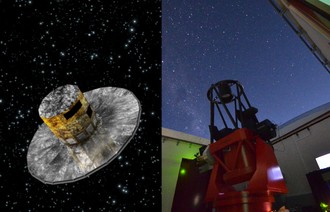
Population II Cepheids are old population pulsating stars. They are less known than famous Classical Cepheids, but are also important distance indicators, primarily because they can be used to measure distances to objects in which Classical Cepheids are not observed (globular clusters, dwarf spheroidal galaxies). Type II Cepheids are observed in many local group galaxies, therefore, as an independent method of distance measurement, they are very useful in determining systematic errors impacting on other methods. Of course, precise distances to Type II Cepheids are extremely important for detailed analysis of these stars, which would help to improve our understanding of stellar evolution and pulsations. Therefore accurate determination of the period-luminosity relationship for type II Cepheids has a significant impact on several branches of astrophysics.
Until now, the Type II Cepheid distance scale was based on the parallaxes of two nearby stars from the Hipparcos satellite, and the accuracy of the zero point was worse than 10%. New, much more accurate parallax measurements for the significantly higher number of stars from the Gaia space mission give the possibility to calibrate the zero point of the Type II Cepheid Period - Luminosity relation with an accuracy close to 1%. However, to achieve that it is also crucial to collect precision photometry, especially in the infrared domain, where the influence of interstellar matter on detected radiation (the so-called extinction) is much smaller than in the visual domain. An ideal instrument for observing these relatively bright stars is the IRIS infrared camera located in the Observatorio Cerro Armazones (OCA, owned by CAMK PAN) in Chile, installed on a 0.8 m telescope. Since 2017, members of the Araucaria project have been conducting photometric observations of nearby stars. This photometric measurements, combined with extremely precise parallaxes from the Gaia mission, will allow to determine the zero point of the cosmic distance scale with the accuracy of 1%.
The photometric data of 21 Type II Cepheids collected with the IRIS camera in the J, H and K infrared bands and their parallaxes from the Gaia Early Data Release 3 allowed for the first determination of the period-luminosity relationship for this class of pulsating stars in the solar neighborhood. The accuracy of the zero point of the period-luminosity relationships is at the level of 5%, which significantly increases the precision of measurements of distances with Type II Cepheids. The influence of metallicity on the absolute brightness of Type II Cepheids was also investigated. The obtained result indicates that the more metal rich Type II Cepheids are intrinsically brighter than their more metal poor counterparts for a given period. This result is in line with the previous empirical determination of this effect from the Cepheids in globular clusters.
Parallaxes used in this work are not the final results of the Gaia mission, thus we should expect more accurate parallaxes of nearby stars in the near future. We plan future observing campaigns for a larger sample of Type II Cepheids to fully harvest from future Gaia results and calibrate P-L relation of Type II Cepheids with a precision close to 1%.
The results are presented in the paper entitled “An absolute calibration of the near-infrared Period-Luminosity Relations for Type II Cepheids in the Milky Way and in the Large Magellanic Cloud” (Wielgórski et al., 2021) which was accepted for publication in The Astrophysical Journal.
Figure 1(top of the note): Presented results were obtained using observations from the Gaia space mission (left panel, artistic view, credit: ESA/ATG medialab). and the IRIS infrared camera installed on the 0,8m telescope located in Observatorio Cerro Armazones (right panel, credit: Michael Ramolla).

Figure 2. Left panel: The Ks band light curve of W Virginis obtained with IRIS. Right panel: the obtained Ks band period-luminosity relation for nearby Type II Cepheids. Gray points are rejected from the fitting procedure (these are peculiar W Virginis stars or stars with low quality parallaxes).
The research leading to these results has received funding from the Polish National Science Center (grants PRELUDIUM 2018/31/N/ST9/02742, MAESTRO 2017/26/A/ST9/00446, BEETHOVEN 2018/31/G/ST9/03050, SONATA BIS 2020/38/E/ST9/00486. SONATA BIS 2018/30/E/ST9/00598), Polish Ministry of Science and Higher Education (DIR/WK/2018/12) and the European Research Council (ERC, under the European Union’s Horizon 2020 research and innovation programme under grant agreement No 695099, project CepBin).
Text: Piotr Wielgórski






